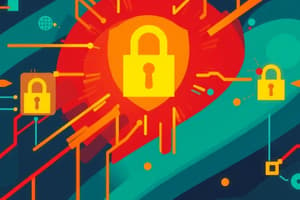Podcast
Questions and Answers
What is a direct consequence of fragmented packets overlapping in a network?
What is a direct consequence of fragmented packets overlapping in a network?
- Improper packet reassembly (correct)
- Reduction in packet size
- Enhanced server communication
- Increased network speed
How does a TCP SYN flood attack obstruct server functionality?
How does a TCP SYN flood attack obstruct server functionality?
- By causing the server to reject all incoming traffic
- By leaving connections unacknowledged (correct)
- By quickly sending messages to the server
- By consuming server storage space
What type of IP addresses does a Smurf attack use to exploit networks?
What type of IP addresses does a Smurf attack use to exploit networks?
- Static IP addresses
- Dynamic IP addresses
- Broadcast IP addresses (correct)
- Only private IP addresses
What is the purpose of using an unreachable source address in a TCP SYN flood attack?
What is the purpose of using an unreachable source address in a TCP SYN flood attack?
What is the primary result of a successful Smurf attack on a network?
What is the primary result of a successful Smurf attack on a network?
What is the primary purpose of ransomware?
What is the primary purpose of ransomware?
Which of the following describes Distributed Denial-of-Service (DDoS) attacks?
Which of the following describes Distributed Denial-of-Service (DDoS) attacks?
What motivates many cybercriminals to commit online fraud?
What motivates many cybercriminals to commit online fraud?
Which type of cybercrime involves unauthorized copying of creative works?
Which type of cybercrime involves unauthorized copying of creative works?
What is the goal of cyberstalking?
What is the goal of cyberstalking?
In what way does cryptojacking compromise a victim's system?
In what way does cryptojacking compromise a victim's system?
What type of cybercrime is often motivated by ideological or political beliefs?
What type of cybercrime is often motivated by ideological or political beliefs?
Which of the following describes identity theft?
Which of the following describes identity theft?
What does Routine Activity Theory emphasize as a crucial factor in cybercrime?
What does Routine Activity Theory emphasize as a crucial factor in cybercrime?
Which of the following best describes a 'suitable target' in the context of cybercrime?
Which of the following best describes a 'suitable target' in the context of cybercrime?
What is a common motivation for offenders in cybercrime according to Routine Activity Theory?
What is a common motivation for offenders in cybercrime according to Routine Activity Theory?
What role does a 'capable guardian' play in the context of cybercrime prevention?
What role does a 'capable guardian' play in the context of cybercrime prevention?
Which of the following is NOT a requirement for learning according to Social Learning Theory?
Which of the following is NOT a requirement for learning according to Social Learning Theory?
Which statement describes the intersection of factors in Routine Activity Theory?
Which statement describes the intersection of factors in Routine Activity Theory?
How does Social Learning Theory relate to criminological behavior?
How does Social Learning Theory relate to criminological behavior?
In the context of cybercrime, which example illustrates a 'motivated offender'?
In the context of cybercrime, which example illustrates a 'motivated offender'?
What is the primary goal of a Denial of Service (DoS) attack?
What is the primary goal of a Denial of Service (DoS) attack?
Which type of attack focuses on consuming all available network bandwidth?
Which type of attack focuses on consuming all available network bandwidth?
Which of the following is an example of a protocol attack?
Which of the following is an example of a protocol attack?
What characterizes application layer attacks?
What characterizes application layer attacks?
What is a common outcome for victim organizations of DoS attacks?
What is a common outcome for victim organizations of DoS attacks?
In a Volume based DoS attack, how does the attacker typically overwhelm the system?
In a Volume based DoS attack, how does the attacker typically overwhelm the system?
What is typically exploited in protocol attacks to consume resources?
What is typically exploited in protocol attacks to consume resources?
Which of the following best describes a Distributed Denial of Service (DDoS) attack?
Which of the following best describes a Distributed Denial of Service (DDoS) attack?
What is the primary focus of cyber law?
What is the primary focus of cyber law?
What are cybercrime laws primarily designed to do?
What are cybercrime laws primarily designed to do?
How do cyber laws protect users in cyberspace?
How do cyber laws protect users in cyberspace?
Which of the following is NOT a role of cybercrime law?
Which of the following is NOT a role of cybercrime law?
What aspect does cybersecurity law primarily focus on?
What aspect does cybersecurity law primarily focus on?
Which of the following actions is supported under cybercrime laws?
Which of the following actions is supported under cybercrime laws?
What is a consequence of not having effective cyber laws?
What is a consequence of not having effective cyber laws?
What does the harmonization of cyber laws aim to achieve?
What does the harmonization of cyber laws aim to achieve?
What factors does the CVSS scoring system consider when evaluating vulnerabilities?
What factors does the CVSS scoring system consider when evaluating vulnerabilities?
Which term is associated with the risk assessment model defined by DREAD?
Which term is associated with the risk assessment model defined by DREAD?
What does STRIDE focus on in threat modeling?
What does STRIDE focus on in threat modeling?
Which best practice emphasizes the importance of involving different stakeholders in threat modeling?
Which best practice emphasizes the importance of involving different stakeholders in threat modeling?
Which of the following methodologies is primarily used for vulnerability scoring?
Which of the following methodologies is primarily used for vulnerability scoring?
What is a key principle of the DREAD model?
What is a key principle of the DREAD model?
How should organizations approach threat modeling according to best practices?
How should organizations approach threat modeling according to best practices?
What aspect does PASTA contribute to threat modeling methodologies?
What aspect does PASTA contribute to threat modeling methodologies?
Flashcards
Malware
Malware
Malicious software designed to harm computer systems, such as viruses, worms, trojans, ransomware, and spyware.
Ransomware
Ransomware
A type of malware that encrypts data and demands payment to restore access. It often targets organizations and critical infrastructure.
Identity Theft
Identity Theft
Stealing personal information, like Social Security numbers and credit card details, to commit fraud.
DDoS attack
DDoS attack
Signup and view all the flashcards
Cyberstalking
Cyberstalking
Signup and view all the flashcards
Online Fraud
Online Fraud
Signup and view all the flashcards
Intellectual Property Theft
Intellectual Property Theft
Signup and view all the flashcards
Child Exploitation
Child Exploitation
Signup and view all the flashcards
Criminological Theory
Criminological Theory
Signup and view all the flashcards
Routine Activity Theory
Routine Activity Theory
Signup and view all the flashcards
Motivated Offender (Cybercrime)
Motivated Offender (Cybercrime)
Signup and view all the flashcards
Suitable Target (Cybercrime)
Suitable Target (Cybercrime)
Signup and view all the flashcards
Capable Guardian (Cybercrime)
Capable Guardian (Cybercrime)
Signup and view all the flashcards
Social Learning Theory
Social Learning Theory
Signup and view all the flashcards
Social Learning & Cybercrime
Social Learning & Cybercrime
Signup and view all the flashcards
Victim Participation Theory
Victim Participation Theory
Signup and view all the flashcards
Cyber Law
Cyber Law
Signup and view all the flashcards
Cybercrime Law
Cybercrime Law
Signup and view all the flashcards
Harmonization of Cyber Laws
Harmonization of Cyber Laws
Signup and view all the flashcards
Cybersecurity Legislation
Cybersecurity Legislation
Signup and view all the flashcards
Cyber Fraud
Cyber Fraud
Signup and view all the flashcards
Cyber-Terrorism
Cyber-Terrorism
Signup and view all the flashcards
Role of Cybercrime Law
Role of Cybercrime Law
Signup and view all the flashcards
Denial of Service (DoS) Attack
Denial of Service (DoS) Attack
Signup and view all the flashcards
Distributed Denial of Service (DDoS) Attack
Distributed Denial of Service (DDoS) Attack
Signup and view all the flashcards
Volume Based DoS Attack
Volume Based DoS Attack
Signup and view all the flashcards
Application Layer DoS Attack
Application Layer DoS Attack
Signup and view all the flashcards
Protocol-Based DoS Attack
Protocol-Based DoS Attack
Signup and view all the flashcards
Fragmented Packet Attack
Fragmented Packet Attack
Signup and view all the flashcards
ICMP Flood Attack
ICMP Flood Attack
Signup and view all the flashcards
TCP SYN Flood Attack
TCP SYN Flood Attack
Signup and view all the flashcards
Teardrop attack
Teardrop attack
Signup and view all the flashcards
Smurf Flood attack
Smurf Flood attack
Signup and view all the flashcards
What is CVSS?
What is CVSS?
Signup and view all the flashcards
What is the DREAD threat model?
What is the DREAD threat model?
Signup and view all the flashcards
What is threat modeling?
What is threat modeling?
Signup and view all the flashcards
What is the STRIDE threat model?
What is the STRIDE threat model?
Signup and view all the flashcards
What is the PASTA threat modeling methodology?
What is the PASTA threat modeling methodology?
Signup and view all the flashcards
Why is it important to involve all relevant stakeholders in threat modeling?
Why is it important to involve all relevant stakeholders in threat modeling?
Signup and view all the flashcards
Why is it important to start threat modeling early in the development process?
Why is it important to start threat modeling early in the development process?
Signup and view all the flashcards
Why is continuous updating and refinement crucial in threat modeling?
Why is continuous updating and refinement crucial in threat modeling?
Signup and view all the flashcards
Study Notes
Introduction to Cybercrime and Threats
- Cybercrime is criminal activity targeting or using a computer, computer network, or networked device.
- Most cybercrime is financially motivated.
- Cybercrime can be committed by individuals or organizations, ranging from novice hackers to highly skilled, organized groups.
- Cybercrime includes hacking, social engineering, phishing, malware, ransomware, identity theft, and cyber espionage.
- Cybercrime poses significant risks to businesses, governments, and individuals.
Types of Cybercrimes
- Malware: Malicious software designed to damage or disrupt computer systems.
- Phishing: Social engineering attacks tricking individuals into revealing sensitive information.
- Password Attacks: Exploiting vulnerabilities in systems to gain unauthorized access.
- DDoS (Distributed Denial-of-Service): Overloading a network, website, or service with traffic to make it unavailable.
- Man-in-the-Middle: Intercepting communications between two parties without their knowledge.
- Drive-by Downloads: Malware downloaded automatically when visiting compromised websites.
- Malvertising: Malware disguised as legitimate advertisements.
- Rogue Software: Software designed to deceive users into revealing sensitive information.
Criminology of Cybercrime
- Criminology is the scientific study of crime, behavior, and the criminal justice system.
- Criminologists use various theories—Routine Activity Theory, Social Learning Theory, and Victim Participation Theory—to understand cybercrime.
- Routine Activity Theory investigates the intersection of motivated offenders, suitable targets, and the absence of capable guardians.
- Social Learning Theory explains how criminal behavior is learned through observation, retention, reproduction, and motivation.
- Victim Participation Theory examines how victims' actions or inactions contribute to their victimization.
- Cybercrime's characteristics differ from traditional crime, with a lack of robust evidence regarding actors in cyberspace.
Cybercrime Investigation
- Cybercrime investigations involve identifying, tracking, and prosecuting those performing illegal activities digitally.
- Investigations utilize digital forensics for evidence collection and analysis.
- Techniques include performing background checks, gathering information, tracking individuals, and using specialized tools and techniques.
- Obstacles include anonymity, the use of proxy servers, and the need for international cooperation.
- Investigators need legal expertise and technical skills.
Cybercrime Laws
- Cyber laws provide a legal framework for activities conducted in cyberspace, addressing issues like data privacy, intellectual property, cybercrime, and electronic commerce.
- Cyber security laws mandate information security measures.
- Cybercrime laws define the offenses and penalties for illegal activities like hacking, identity theft, and cyber-terrorism.
- Cyber crime laws address issues like the harmonization of national laws and the role of law enforcement.
Corporate Data
- Corporate data encompasses structured, unstructured, and semi-structured data.
- Valuable data includes financial statements, sales reports, customer databases, employee records, and market research data.
- Hackers often target personally identifiable information (PII) such as social security numbers and financial details, and digital infrastructure.
Cyber Threats
- Cybercriminals may use various means— such as phishing, malware, or other social engineering techniques—to attain their goals.
- Nation-state actors, or a nation's government-connected groups, conduct activities like cyber espionage.
- Insider threats originate from individuals within an organization who misuse their access.
- Hacktivists use hacking as a form of protest.
- Advanced persistent threats (APTs) are highly organized and sophisticated groups.
- Script kiddies are inexperienced or amateur hackers using automated or pre-programmed tools.
Cyber Policy
- A security policy defines and outlines rules, expectations, and methods for maintaining confidentiality and integrity of data.
- Effective security policies include a clear purpose, scope, and commitment from senior management.
- Policies are organized into program, issue-specific, and system-specific types.
- Policy elements include clear objectives, scope, management commitment, realistic policies, and up-to-date information.
Denial of Service (DoS) Attacks
- A DoS attack floods a server with data packets to overwhelm its resources, making the service unavailable.
- Classifications include volume-based (bandwidth attacks), protocol attacks (resource starvation), and application layer attacks.
- Types of DoS attacks include UDP floods, SYN floods, ICMP floods, Ping of Death, Teardrop, Land, and Nuke attacks.
- DDoS attacks involve multiple computers launching an attack, making them harder to defend against.
Cyber Threat Modeling
- Cyber threat modeling is the systematic identification and mitigation process of vulnerabilities
- It helps to determine the possible threats to assets, how and when they could be mitigated
- Benefit includes early identification of potential threats, improved understanding of security posture, cost effective risk management, and enhanced collaboration
Cyber Kill Chain
- The Cyber Kill Chain is a framework for understanding how cyber attacks occur
- It consists of stages such as Reconnaissance, Weaponization, Delivery, Exploitation, Installation, Command and Control, and Actions on Objectives
- Each stage offers a place to implement security measures to prevent attackers
- The kill chain is used to identify vulnerabilities, mitigate security risks, and anticipate threats
Studying That Suits You
Use AI to generate personalized quizzes and flashcards to suit your learning preferences.



